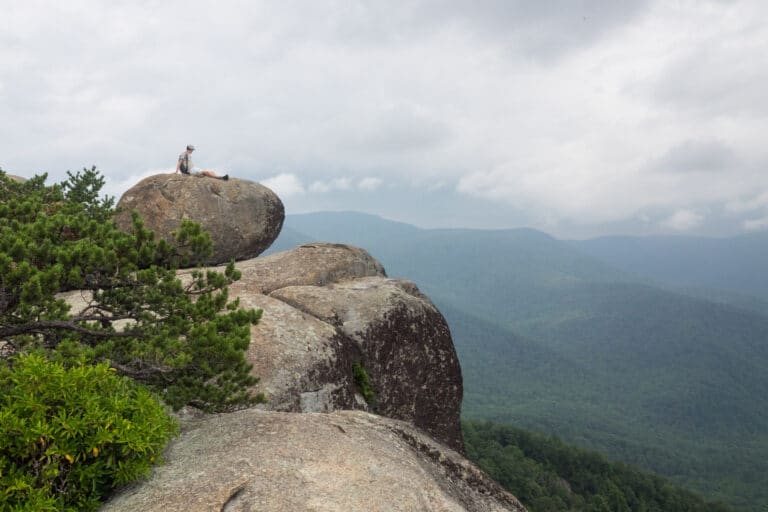A wonderful hike in Georgia’s Chattahoochee National Forest is the Bear Creek & Pinhoti Trails, near the Cohutta Wilderness Area. The trailhead is around 6 miles north of Ellijay, Georgia and follows Bear Creek, then leads to the Mountaintown roadless area. The whole area is a hot spot for mountain biking and hiking, with a great network of trails, including the well-known Pinhoti Trail.
Georgia Forest Watch’s executive director, Wayne Jenkins suggested this trail to me and I was lucky enough to spend a day hiking it with him. The trail begins by following a sweet, peaceful stream named (you guessed it) Bear Creek. Large evergreen hemlocks dominate the cove, creating a magical, cool-shaded setting for our afternoon summer hike.
After 1.2 miles, the Bear Creek Trail intersects the Pinhoti, leading over a low gap and into the Mountaintown Creek roadless area, then down to Mountaintown Creek. Talk about beautiful! I could feel the tensions of modern life ease as I walked the woodland trails. In total, we hiked about 3.6 miles, but again, this area has a network of trails, so there are many options. Make sure you take a map!
While walking in this Hemlock-rich forest, Wayne described the important role of Hemlock trees in our mountain forests – and the looming threat of an exotic insect infestation targeting these trees. The threat is real – the Hemlock Woolly Adelgid (HWA) is native to Asia but deadly to our hemlocks – and these devastating insects are creeping down the Appalachians. Many areas in Georgia’s Chattahoochee are already infested, but the Bear Creek area is still unaffected.
I learned that Hemlocks are not only perhaps the most aesthetically-pleasing evergreen tree in the region, but play a tremendous ecological role in the Southern Appalachians, cooling streams, sheltering bird and mammal species, moderating winter ground temperatures, and holding steep stream banks in place. Hemlocks are an irreplaceable and majestic part of our mountain forests – often hundreds of years old – and are a critical component for maintaining the cool stream temperatures necessary for trout and native fish species.
When first discovered in Georgia a plan was needed for study and treatment of the impacts of the invasive Adelgid. Georgia ForestWatch stepped up and helped the Forest Service craft a plan and identify critical areas of immediate concern. Particularly, the loss of Hemlock trees would affect campgrounds and popular recreation areas by turning cool, forested areas into warmer openings with tree clogged streams.
One approach to dealing with the HWA is introduction of several beetle species that feed exclusively on the adelgids. There are other methods to treat the Hemlocks, but due to the cost and scale of the problem these are not viable across the forest. So the idea, though experimental, is to introduce the beetles to the infested areas and hope they breed, populate, and eventually control the Adelgid population before the demise of the Hemlocks.
Georgia ForestWatch, the University of Georgia and the USDA Forest Service have teamed up with the Georgia Forestry Commission, the Georgia Department of Natural Resources, the Georgia Wildlife Federation, the Georgia Conservancy, and others to organize a fundraising campaign and secured a beetle production facility. Together, the groups are moving forward in fighting this foreign, devastating insect.
In the meantime, make sure to get out and enjoy hikes like the Bear Creek Trail. I, for one, was grateful for the shade produced by the Hemlocks on this hot Georgia afternoon hike!
To get there: From Ellijay, take GA 76 west about 5 miles to Gates Chapel Road. Follow Gates Chapel road for about 3 ½ miles and turn right on Forest Service road 241. Follow the signs to the Bear Creek Trailhead.








